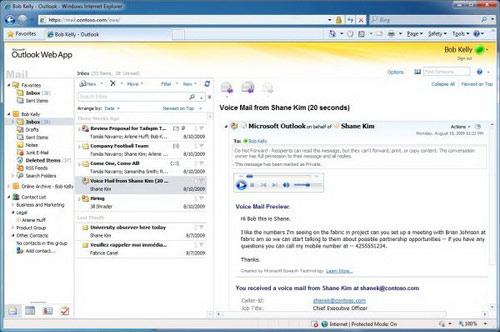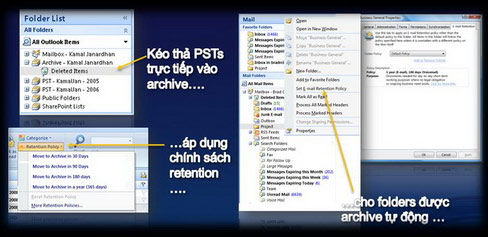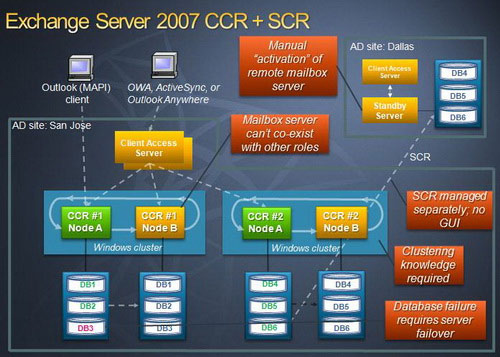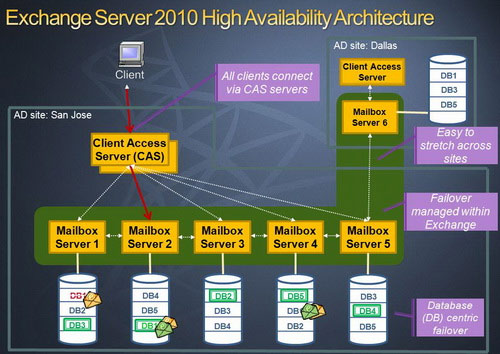Exchange Server 2010: many outstanding improvements
After Windows 7 officially launched, all the attention of the tech community continued to pour into Microsoft's next " brand name " product, Exchange Server 2010 equipped with many new features and significant improvements from 2007 version.
There are a lot of major changes in Exchange Server 2010 compared to previous versions, but the following 10 highlights have covered the transformation of this powerful digital media solution:

Exchange Server 2010 web-based interface (Outlook Web App) with many improvements
1. Improve management methods
Exchange Server 2010 offers a Role-Based Access Control (RBAC) model, temporarily called role-based control, which is the opposite of the permission-based Access Control List model. term) in previous models. This is considered one of the major improvements of Exchange Server to reduce the load for administrators, and also requires careful consideration in decentralization to avoid overlap.
2. New information storage model
Exchange Server is a server software developed by Microsoft that specializes in email solutions and information exchange within businesses.The main feature of Exchange Server is managing email, calendar, user contacts and tasks, supporting users through desktop environment, mobile phone and web browser.
The mailbox server recovery capability uses Database Available Group (DAG), a completely new extensibility function from Cluster Continuous Replication (CCR) functionality already in Exchange Server 2007. It allows users to run a second mailbox server in order to Quick recovery when needed. DAG is not completely available in Exchange Server 2003, replacing classic clustering models or storing information as Storage Area Network (SAN).
DAG model can create up to 16 copies for each Mailbox database. Backup copies (replica) can be configured to automatically fault.
3. Simplify Archiving
Exchange Server 2010 allows moving emails from their mailboxes to more suitable and secure places without using third-party solutions like before. This solution also includes the Personal Archive function, which can appear on the user's Microsoft Outlook interface. Can search simultaneously with many other mailboxes through decentralization and advanced information filters.

Archive helps store email better
4. Allow decentralized self-administration with ECP tools
The new tool with a web interface called Exchange Control Pannel (ECP) will allow administrators to do everything in an Exchange 2010 environment without having to install any application on the Client machine.
5. Server upgrade will also need to upgrade Exchange Server
Windows Server 2008 R2 currently only supports Exchange Server 2010 (no previous Exchange versions are supported).
6. Email flow via CAS tool
The role of Client Access Server (CAS) will be responsible for all forms of mail connectivity including connecting MAPI (Outlook) clients, improving the expansion of mail infrastructure systems easily.


HA architecture model (high availability) of Exchange Server 2007 (above)
compared to HA model of Exchange Server 2010 (below) - (Photo: Microsoft)
7. Restore menu
In previous versions of Exchange Server, users could delete items they didn't like. This makes administrators spend a lot of time to recover when required. Exchange Server 2010 provides longer email storage times to assist users in recovering when needed. The Litigation Hold function available on certain email categories prevents users from deleting in any case.
8. OWA premium for firefox
In addition to Internet Explorer, Exchange Server 2010 Outlook Web Access (OWA) supports web browsers such as Firefox or Safari. OWA also has new features such as sharing calendars (Share Calendars) or Contacts , adding functions to integrate user status.
9. Windows Mobile
Windows Mobile smartphone users will have a completely new Outlook interface on Mobile, especially the Conversation View function that allows to view a series of emails of the same subject in a single entity. Furthermore, text messages on Windows Mobile will be synchronized immediately with the Server mailbox.
10. Speed improvements
In Exchange 2007, the combination of 64-bit architecture and increased page sizes to 8 KB resulted in a 70% reduction in write readings for Exchange on the hard disk. With Exchange 2010, the page size is increased to 32 KB, which helps reduce IOPS rate by 50%. Thus businesses can review the use of cheaper hard disks without losing any capabilities of the system.
Some limitations
- Exchange 2010 is built on Windows PowerShell , a command line processing technology. Although it is easier for administrators to handle than Exchange 2003, it requires training of IT staff, especially those who are still used to the mouse and the graphical interface.
- Exchange 2010 only runs on Windows 2008 SP2 or higher versions, which also means that administrators need to know more about the functionality of the new operating system.
- Exchange 2003 can run on Microsoft Virtual Server 2005 but Exchange 2010 will only run on new Microsoft virtual servers like Hyper-V or on VMware servers.
In general, Exchange Server 2010 can appear everywhere via Outlook on a PC, smartphone or web browser, providing end-user features such as voicemail content preview, SMS Text Messaging , MailTips , Conversation View , Call Asnwering Rule , help customers protect information, allow them to encrypt email based on sender, recipient information or even based on the content of the message or attachment.
When combined with the latest Forefront Protection for Exchange, the IT department can add eight layers of security, preventing viruses, malware, and spyware from being more effective for Exchange Server 2010.
In Vietnam market, Exchange Server accounts for 80% market share in large enterprises, 73% of medium enterprises and 41% in education networks. Customers can choose solutions such as installing on enterprise servers, using online subscription form with servers stored at Microsoft datacenter or can combine the above two forms.
In Vietnam, the following two forms have been deployed free of charge for many domestic universities and educational institutions through the Live @ edu program with the number of hundreds of thousands of email accounts created for students. Each student owns a permanent personal mailbox with up to 10GB - 25GB of online storage.
Exchange 2010 Online is being used by 10 million students globally over the past year. It is expected that by 2011, this service will be ready for business customers in Vietnam.
According to Microsoft Vietnam
You should read it
- BlackBerry Enterprise Server 5.0 supports Exchange 2010
- Email: Differences between POP3, IMAP and Exchange
- How to set up SMTP server to send email using Outlook.com address
- Configure, set Incoming and Outgoing Email on SharePoint 2010 - Part 2
- Configure, set Incoming and Outgoing Email on SharePoint 2010 - Part 3
- 7 ways to filter, classify and search effective email
- Configure Exchange 2007 or 2010 to forward email to the secondary domain
- Configure, set Incoming and Outgoing Email on SharePoint 2010 - Part 1
May be interested
- Transfer Exchange 2003 to Exchange 2007 (Part 3)
 in the previous two sections, we installed the first exchange 2007 servers, combining hub transport and client access servers in an exchange 2003 environment.
in the previous two sections, we installed the first exchange 2007 servers, combining hub transport and client access servers in an exchange 2003 environment. - Transfer Exchange 2003 to Exchange 2007 (Part 1)
 in this series, we will learn how to migrate data from exchange server 2003 system to exchange server 2007 system.
in this series, we will learn how to migrate data from exchange server 2003 system to exchange server 2007 system. - Discover EMC in Exchange Server 2010 (Part 1)
 in exchange server 2010, powershell cmdlets has been greatly improved to manage multiple tools, and administrative tasks are made easier on emc.
in exchange server 2010, powershell cmdlets has been greatly improved to manage multiple tools, and administrative tasks are made easier on emc. - Forward from Exchange 2000/2003 to Exchange Server 2007 (part 2)
 this is the next installment of a series of three tutorials on how to forward a server from exchange 2000 or 2003 to exchange 2007, deployed in the same active directory forest. for the purposes of this article, we will only install an exchange 2007 server, with the chapter
this is the next installment of a series of three tutorials on how to forward a server from exchange 2000 or 2003 to exchange 2007, deployed in the same active directory forest. for the purposes of this article, we will only install an exchange 2007 server, with the chapter - Discover the new Export List feature of Exchange Server 2007 Service Pack 1
 exchange server 2007 service pack 1 (sp1) introduces many new gui features for the user interface (ui) of the exchange management console. we have introduced a lot of new features as well as improvements to pre-existing ui features in some of the previous articles and themes. in this article, we will only introduce a t & iacu
exchange server 2007 service pack 1 (sp1) introduces many new gui features for the user interface (ui) of the exchange management console. we have introduced a lot of new features as well as improvements to pre-existing ui features in some of the previous articles and themes. in this article, we will only introduce a t & iacu - Microsoft continues to 'delay' the plan to launch a new version of Exchange Server for another 4 years
 currently, with a focus on security, microsoft has just announced that the next version of exchange server will be released in the second half of 2025.
currently, with a focus on security, microsoft has just announced that the next version of exchange server will be released in the second half of 2025. - Mobile communication with Exchange Server 2007 - Part 2: Mobile device management
 in part 1, we still leave some new features and improvements provided through a combination of windows mobile 6.0 and exchange server 2007 devices. in part 2, we will introduce you. about properties
in part 1, we still leave some new features and improvements provided through a combination of windows mobile 6.0 and exchange server 2007 devices. in part 2, we will introduce you. about properties - Replace the Exchange 2003 Frontend OWA server
 in this article we will show you the advantages and disadvantages of replacing the exchange 2003 front-end owa server with exchange server 2007 client access.
in this article we will show you the advantages and disadvantages of replacing the exchange 2003 front-end owa server with exchange server 2007 client access. - Use remote connection analysis tool for Exchange Server - Part 1
 in this article we will introduce you to the exchange server remote connectivity analyzer (exrca) tool so that administrators can validate autodiscover, ....
in this article we will introduce you to the exchange server remote connectivity analyzer (exrca) tool so that administrators can validate autodiscover, .... - Microsoft begins offering Exchange Server updates in .exe packages
 currently, microsoft has maintained a policy of releasing exchange server security updates (exchange server security updates - su) and hot patches (hotfixes - hf) as windows installer patch files (.msp).
currently, microsoft has maintained a policy of releasing exchange server security updates (exchange server security updates - su) and hot patches (hotfixes - hf) as windows installer patch files (.msp).










 Install and use Claws Mail in Windows
Install and use Claws Mail in Windows Install and configure the solution to handle email on TMG 2010 Firewall - Part 1: Installation
Install and configure the solution to handle email on TMG 2010 Firewall - Part 1: Installation Instructions for installing MDaemon Mail Server
Instructions for installing MDaemon Mail Server Install and configure email handling solutions on TMG 2010 Firewall - Part 2: E-Mail Policy
Install and configure email handling solutions on TMG 2010 Firewall - Part 2: E-Mail Policy Install and configure email handling solutions on TMG 2010 Firewall - Part 3
Install and configure email handling solutions on TMG 2010 Firewall - Part 3 Security features of OWA (P.3)
Security features of OWA (P.3)